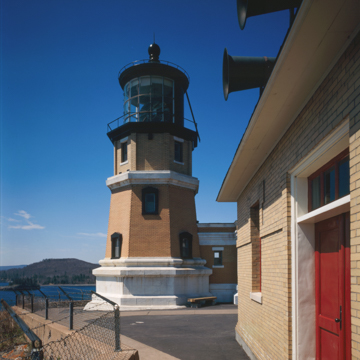Dramatically sited on a 130-foot-high rock cliff above Lake Superior near Beaver Bay in Minnesota, Split Rock Lighthouse was built in 1909–1910 as part of a federal effort to improve navigation on the Great Lakes. In particular, the government focused on Lake Superior, where a 1905 storm had damaged or sunk thirty ships. By the early twentieth century, Lake Superior had become one of the busiest shipping corridors in the world but it was also a very dangerous inland sea, prone to extreme weather conditions that often changed quickly from calm sailing to thick fog, violent storms, and strong northeast winds liable to drive ships onto rocky shores or underwater reefs.
Split Rock Lighthouse was designed by Ralph Russell Tinkham, an engineer for the Eleventh Lighthouse District in Detroit. The 54-foot-high octagonal lighthouse has riveted steel framework enclosed in buff-colored brick. The tower and its one-story, flat-roofed wing rests on a poured concrete foundation and floor. The steel and glass lantern room at the top of the tower houses a Third Order Fresnel lens made by Barbier, Benard and Turenne of Paris. The lens sits on a complex rotating assembly that uses a clock-weight system to turn the lens assembly every twenty seconds. The lens and its rotation assembly weigh six-and-one-half tons. The light has an official range of twenty-two miles. Its 220,000 candlepower rating makes it one of the most powerful on the Great Lakes. Split Rock was Tinkham’s first lighthouse design; he went on to became chief engineer for the U.S. Lighthouse Service in 1935.
Lighthouses are first and foremost functional navigational structures whose locations often limit the design, construction technology, and materials that can be utilized. Despite its difficult location atop a cliff and accessibility only by water (all construction materials were brought in by boat), Tinkham was able to incorporate Classical Revival architectural elements into his design for Split Rock Lighthouse, including heavy stone cornices, pilasters, and symmetrically arranged fenestration.
Besides the lighthouse itself, other buildings and structures that form the Split Rock Light Station complex include three lightkeeper’s houses, a fog horn building, oil house, three storage barns, a pumphouse, tramway engine house, tramway, derrick, and a boat house and pier, in addition to several stone walls and other miscellaneous structures.
Completion of a road along the north shore of Lake Superior in 1925 quickly attracted tourists. By the 1930s, Split Rock was the most visited lighthouse in the country. Split Rock Lighthouse functioned as a navigational aid until it was decommissioned in 1969. Today it is a very popular historic site that is owned and operated by the Minnesota Historical Society.
References
Faltinson, Brian J. “Split Rock Light Station National Historic Landmark Nomination.” Menomonee Falls: Heritage Research, Ltd., 2008.
Ferguson, John R., “Split Rock Lighthouse,” Lake County, Minnesota. National Register of Historic Places Inventory–Nomination Form, 1969. National Park Service, U.S. Department of the Interior, Washington, D.C.

